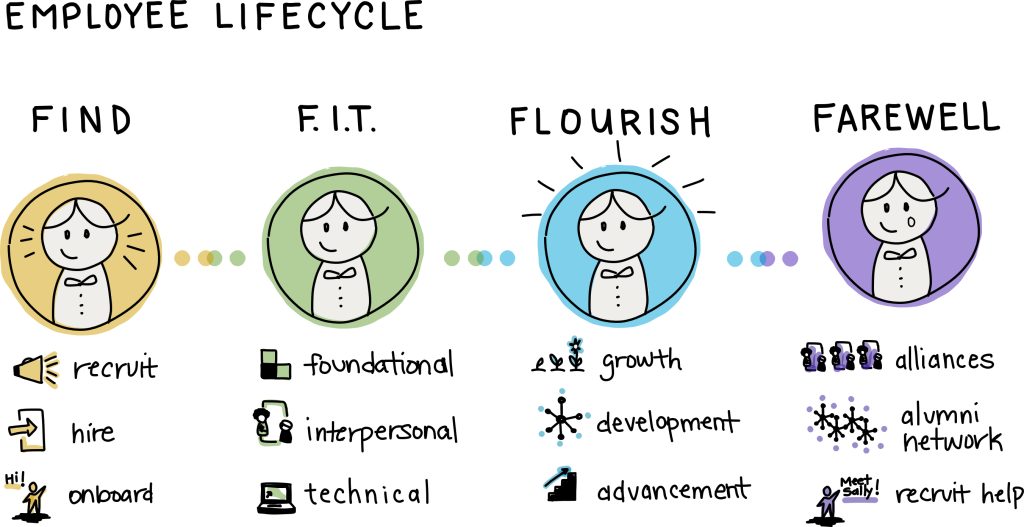
The Employee Lifecycle
is a model that describes the entire journey of an employee at a company or organization, from their initial awareness of the company to their eventual departure from that company. Several versions of the model exist; I prefer the simplicity of the four-phase models.
The above sketch is my version of a four-phased Employee Lifecycle designed to fit my organization’s needs. In this version, the four phases (Find, F.I.T., Flourish, and Farewell) each consist of three sub-phases that can be followed to create a solid foundation for new employees:
- Prospective employees can easily Find out about the organization, get hired, and onboard.
- Recruitment efforts should be streamlined, inclusive and transparent.
- The hiring process should be technically seamless and inclusive to people of color and neurodivergent people.
- Onboarding should be a continuous, year-long process that is tailored to both the needs of the role and the employee.
- New employees complete additional training to better F.I.T. into their roles.
- Foundational training focuses on building skills that are core to the role and/or business (things like standard operating procedures).
- Interpersonal training focuses on building soft skills (e.g., Crucial Conversations).
- Technical training focuses on learning or building upon existing knowledge in software or specialized skillsets, like project management or accessibility.
- Existing employees have paths to Flourish in their roles.
- Equitable opportunities for growth, development, and advancement are universally designed and made available to all employees.
- Existing employees say Farewell to their role and/or the organization.
- Employees often form alliances within and outside of the organization that they later turn to for networking and career growth opportunities. It only makes sense for organizations to form a relationship with their employees that allows the organization to tap into that network, which leads us to:
- Organizations that form alumni alliance networks and make it easy for those networks to recruit and refer new candidates are poised to maximize the investment they’ve made in their employees.
In my experience, most org’s overinvest in the Find and F.I.T. phases and pay little attention to the Flourish and Farewell phases.
So, why tf does this matter?
This matters because it costs organizations a shit ton of money when they underinvest in the Employee Lifecycle.
According to the Work Institute’s 2024 Retention Report, most of the top reasons for leaving are preventable. And:
“U.S. Companies spent nearly $900,000,000,000 to replace
employees who quit in 2023.”
tl;dr: When you invest in your Employee Lifecycle, it saves you money.

Leave a Reply